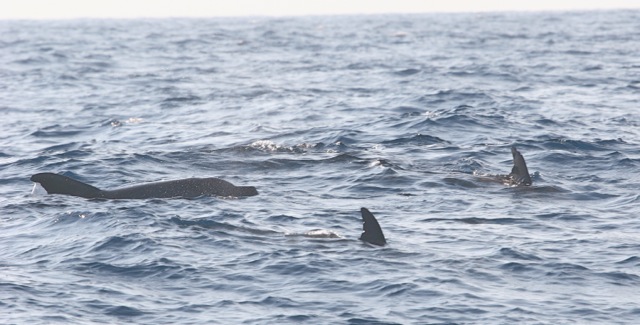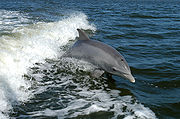Common Name: Common Bottlenose Dolphin
Tursiops spp: The Tursiops genus has been split into two, T. truncatus and T. aduncus. The taxonomy of this genus is still not thoroughly clear, however due to considerable geographic variations, additional species may be recognised in the future.
General Description: Bottlenose dolphins have a large, robust head and trunk; the snout is clearly demarcated from the bulbous forehead by a sharp crease. The beak is usually short and stubby and the lower jaw protrudes conspicuously beyond the upper. The dorsal fin is moderately tall and falcate. The flippers are somewhat long and pointy at tips. The colouration is variable, but usually dark or slate grey on back, grading to white or pink on the belly. Adult dolphins may also have a white mark on the tip of the lower jaw. Calves have a slightly blue-grey colouration.
Size: Calves: Length of animals at birth is approximately 1-1.3 m. Adults: Adult dolphins are between 1.9-3.8 m, males tend to be slightly larger than the females. Maximum weight is around 650kg.
Appearance At Sea: This is the species of dolphin best known to the general public, as a result of exhibition in dolphinaria and films and television. Group sizes are mostly <20, however larger pods have been observed in offshore areas. They often school with other species including short-fin pilot whales.

The Bottlenose Dolphin is found in small herds that sometimes gather into much larger schools. They often school with other species including Short fin Pilot Whales.

Bottlenose Dolphins can reach speeds of 25 kilometres per hour.
Found In: Two forms are bottlenose dolphins are known, coastal and offshore. May be found in depths ranging from 10-1000 m or more. Most dolphins are known to feed off a wide variety of prey species, including fish, and squid. Groups are known to communicate and cooperate between themselves for hunting food. They are sometimes known to eat shrimp and other crustaceans.
World Distribution: Found across coastal and continental shelf waters of tropics and temperate regions and associated with reef systems. Also occur in enclosed or semi-enclosed seas. Distribution is restricted to lower altitudes.
Could Be Confused With: In areas where they overlap in distribution, common bottlenose dolphins can be confused with Indo-Pacific bottlenose dolphins and rough toothed dolphins.
Diagnostic Features at sea: Can be distinguished from Indo-Pacific bottlenose dolphins based on overall size, shape of head and beak and colouration. Ventral spotting is very rare, unlike Indo-Pacific bottlenose dolphins.
Stranded Specimens: Stranded individuals can best be identified based stubby beak and robust bodies. Teeth count is usually between 18-27 pairs in each jaw, teeth are stout and pointy and smooth.
Note: Several previous records of Tursiops truncatus could be misidentifications as they need to be assessed for T. aduncus.




